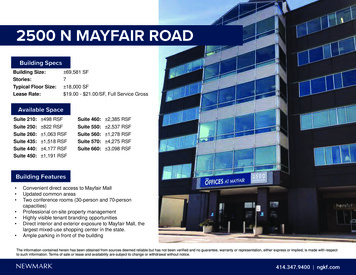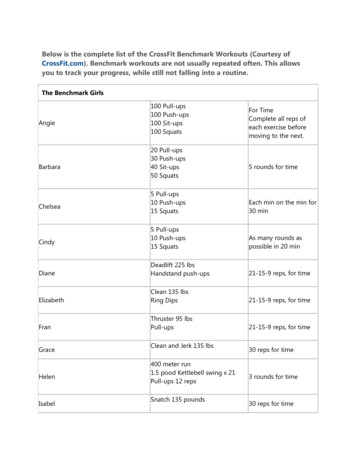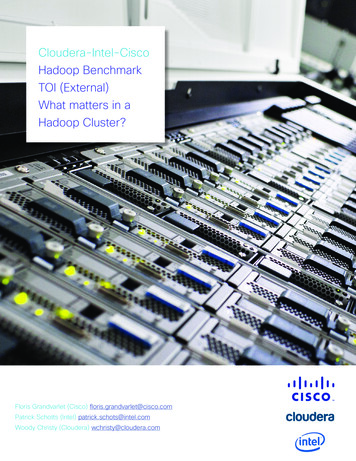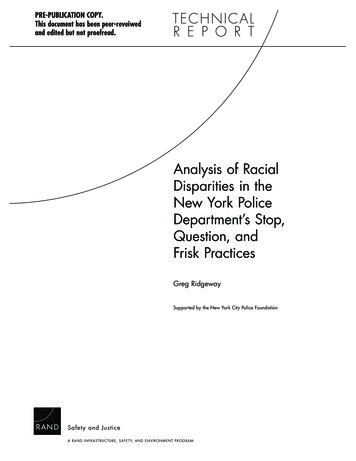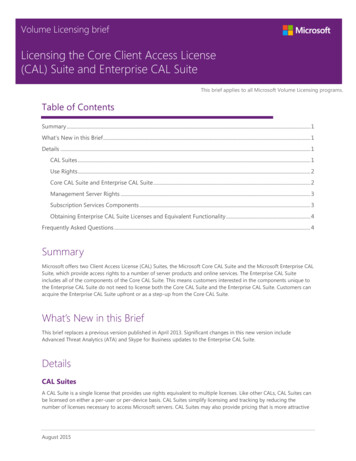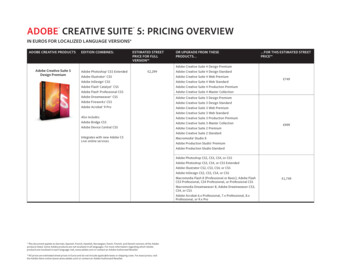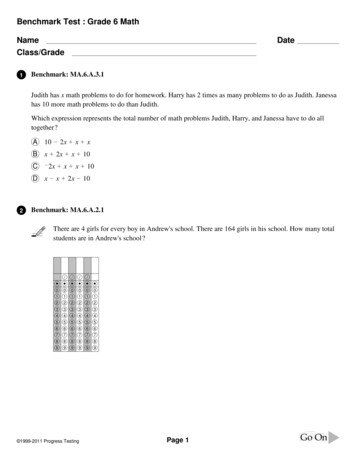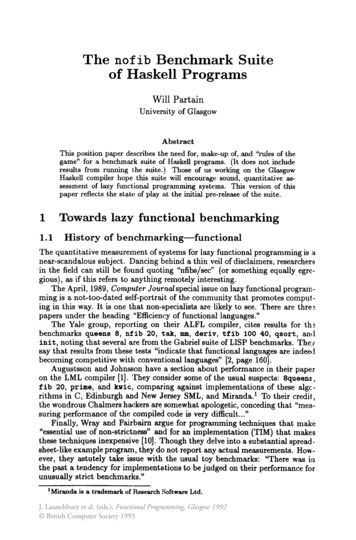
Transcription
The nofib Benchmark Suiteof Haskell ProgramsWill PartainUniversity of GlasgowAbstractThis position paper describes the need for, make-up of, and "rules of thegame" for a benchmark suite of Haskell programs. (It does not includeresults from running t.he suite.) Those of us working on the GlasgowHaskell compiler hope this suite will encourage sound, quantitative assessment of lazy functional programming systems. This version of thispaper reflects the state of play at the initial pre-release of the suite.1Towards lazy functional benchmarking1.1History of benchmarking-functionalThe quantitative measurement of systems for lazy functional programming is anear-scandalous subject. Dancing behind a thin veil of disclaimers, researchersin the field can still be found quoting "nfihs/sec" (or something equally egregious), as if this refers to anything remotely interesting.The April, 1989, Computer Journal special issue on lazy functional programming is a not-too-dated self-portrait of the community that promotes computing in this way. It is one that non-specialists are likely to see. There are thre papers under the heading "Efficiency of functionallang·uages."The Yale group, reporting on their ALFL compiler, cites results for th benchmarks queens 8, nfib 20, talt, mm, deriv, tfib 100 40, qsort, andinit, noting that several are from the Gabriel suite of LISP benchmarks. The:{say that results from these tests "indicate that functional languages are indeedbecoming competitive with conventional languages" [2, page 160].Augustsson and Johnsson have a section about performance in their paperon the LML compiler [1]. They consider some of the usual suspects: 8queenf,fib 20, prime, and kwic, comparing against implementations of these algcrithms in C, Edinburgh and New Jersey SML, and Miranda. 1 To their credit,the wondrous Chalmers hackers are somewhat apologetic, conceding that "measuring performance of the compiled code is very difficult . "Finally, Wray and Fairbairn argue for programming techniques that make"essential use of non-strictness" and for an implementation (TIM) that makesthese techniques inexpensive [10]. Though they delve into a substantial spreadsheet-like example program, they do not report any actual measurements. However, they astutely take issue with the usual toy benchmarks: "There was illthe past a tendency for implementations to be judged on their performance forunusually strict benchmarks."1 Mirandais a trademark of Research Software Ltd.J. Launchbury et al. (eds.), Functional Programming, Glasgow 1992 British Computer Society 1993
1961.2History of benchmarking-imperativeOur imperative-programming colleagues are not far removed from our brutishbenchmarking condition. Only a few years ago, "MIPS ratings," Dhrystonesand friends were all the rage: marketeers bandied them about shamelessly,compiler writers tweaked t heir compilers to spot specific constructs in certainbenchmarks, users were baffled, and no-one learned much that was worth knowing. The section on performance in Hennessy and Patterson's standard text oncomputer architecture is an admirable expose of these shenanigans and is wellworth reading [7].Then, in 1988, enter the Standard Performance Evaluation Corporation(SPEC) benchmarking suite. The initial version included source code andsample inputs ("workloads") for four mostly-integer programs and six mostlyfloating-point programs. These are all either real programs (e.g., the GNU Ccompiler) or the "kernel" of a real program (e.g., matrix300, floating-pointmatrix multiplication). Computer vendors have since put immense effort intoimproving their "SPECmarks," and this has delivered real benefit to the workstation user.1.3Towards lazy benchmarkingThe SPEC suite is the most visible artifact of an important shift towards system benchmarking. A big reason for the shift lies in the benchmarked sye-terns themselves. Fifteen years ago, a typical computer system-hardware andsoftware-probably came from one manufacturer, sat in one room, and was acomputing environment all on its own.An excellent discussion about benchmarking from the self-contained-sYEterns era is Gabriel and Masinter's paper about LISP systems [4]. "The properrole of benchmarking is to measure various dimensions of Lisp system performance and to order those systems along each of these dimensions" (page 136).A toy benchmark, of the type I have derided so far, can focus on one of thes "dimensions," thus contributing to an overall picture.Much early measurement work in functional programming was of this plotalong-dimensions style; however, the concern was usually to assess a particularimplementation technique, not the system as a whole. For example, Hailperr,Huynh and Revesz tried to compare systems that use strict versus lazy evaluation [5]. They went to considerable effort to factor out irrelevant details, hopingto end up with pristine data points along interesting dimensions. Hartel's effortto characterise the relative costs of fixed-combinator versus program-derivedcombinator implementations was even more elaborate, using non-toy SASLprograms [6].So, can SPEC be seen as a culmination of good practice in benchmarkingby-characteristics? No! SPEC makes no effort to pinpoint systems along "interesting" dimensions, except for the very simplest-elapsed wall-clock time.An underlying premise of SPEC is that systems are sufficiently complicatedthat we probably won't even be able to pick out the interesting dimensions tomeasure, much less characterise benchmarks in terms of them. SPEC representsa shift to lazy benchmarking of systems.Conte and Hwu's survey confirms that, at least in computer architecture,this shift towards "lazy, system-oriented benchmarking" is supported as a Good
197Thing [3]. The trend can also be seen in some specialised areas of computing:the Perfect Benchmarks for supercomputers (Crays, etc., running FORTRANprograms) [8] and the Stanford benchmarks for parallel, shared-memory systems [9] are two examples.2Some serious benchmarks, nofibWe, the Glasgow Haskell compiler group, wish to (help) develop and promotea freely-available benchmark suite for lazy functional programming systems-called the nofib suite-consisting of:1. Source code for "real" Haskell programs to compile and run;2. Sample inputs (workloads) to feed into the compiled programs, along Witllthe expected outputs;3. "Rules" for compiling and running the benchmark programs, and (morenotably) for reporting your benchmarking results; and4. Sample reports, showing by example how results should be reported.2.1Our (non-) motivations in creating this suiteBenchmarking is a delicate art and science, and it's hard work, to boot. Wehave quite limited goals for the nofib suite, are hoping for lots of help, and areprepared to overlook considerable shortcomings, especially at the beginning.2.1.1Motivations. Our main initial motivation is to give functional-language implementOIs(including ourselves) a common set of "real Haskell programs" to attackand study. We encourage implementors to tackle the problems that actually make Haskell programs large and slow, thus hastening solutions bthose problems.And of course, because the benchmark prognms are shared, it will be po sible to compare performance results between systems running on identicalhardware (e.g., Chalmers HBC vs. Glasgow Haskell, both running on thesame Sun4). Racing is the fun part! Our ultimate motivation for this benchmark suite is to provide "end users"of Haskell implementations with a useful predictor of how those systemswill perform on their own programs.The initial nofib suite will have no value as a predictive tool. Perhapsthose with greater expertise \'I'ill help us correct this. If necessary, we widgladly hand over "the token" for the suite to a more disinterested part). We are very keen on (some might say "paranoid about") readily-acceEsible reproducible results. Tha.t is the whole point of the "reporting rules 'elsewhere in this paper.Good-but-irreproducible benc:hmarking results are very damaging, b{cause they lull implementors into a false sense of security.
198 After the initial pre-release of the suite, which will be for (possibly major)debugging, we intend to keep t.he suite stable, so that sensible comparisonscan be made over time . Having said that, benchmarks must change over time, or they becomestale. It is difficult to brim with confidence about the Gabriel benchmarksfor LISP systems; they are more than a decade old.Being forced to change a benchmark suite can be a mark of success. TheSPEC people made substantial changes to their suite in 1992: so muchwork had gone into compiler tricks that improved SPEC performanceresults that some tests were no longer useful (notably the matrix300 testmentioned earlier).2.1.2 Non-motivations.We are profoundly uninterested in distilling a "single figure of merit" (e.g,MIPS) to characterise a Haskell implementation's performance.Initially at least, we are also uninterested in any statistics derived from th raw nofib numbers, e.g., various means, standard deviations, etc. You maycalculate and report any such numbers-all honest efforts to understand thesebenchmarks are welcome--but the raw, underlying numbers must be readilyavailable.An important issue we are not addressing with this suite is inter-languagecomparisons: "How does program X written in Haskell fare against the sameprogram written in language Y?" Such comparisons raise a nest of issues alltheir own; for example, is it really the "same" program when written in the twocompared languages? This disclaimer aside, we do provide the nofib programsources in other languages if we happen to have them.2.2The Real subsetThe nofib programs are divided into three subsets: Real, Imaginary, and Spectral (somewhere between Real and Imaginary).The Real subset of the nofib suite is by far the most important. In fact,we insist that anyone who wishes to report any results from running this suite(in whatever form) must first distribute their complete, raw results for the Ree Isubset in a public forum (e.g., available by anonymous FTP).The programs in the Real subset are listed in Table 1. Each one meets mostof the following criteria: Written in standard Haskell (version 1.2 or greater). Written by someone trying to get a job done, not. by someone trying tl)make a pedagogical or stylistic point. Performs some useful task such that someone other than the author mightwant to execute the program for other than watch-a-demo reasons. Neither implausibly Hmall or impossibly large (the Glasgow Haskell compiler, written in Haskell, falls in the latter category).
tDescriptionStrictness analyserarbitrary-precision calculatorText compressionFluid-dynamics programMonte Carlo photon transportGraphs from GRIP statisticsHaskell program generatorHindley-Milner type inferenceFully-lazy lambda Mailing-list generatorHaskell program skeletonsPartial Haskell parserParticle in cell"mini-Prolog" interpreterEscher tiling programTheorem-proverOriginJulian Seward (Manchester)Liang & Mirani (Yale)Paul Sanders (BT)Xiaoming Zhang (Swansea)Pa.t Fasel (Los Alamos)lain Checkland (York)Nick North (NPL)Phil Wadler (Glasgow)David Lester (Manchester) &Simon Peyton Jones (GlasgowlPaul Hudak (Yale)Nick North (NPL)Julian Seward (Manchester)Pat Fasel (Los Alamos)Mark Jones (Oxford)Sandra Foubister (York)Gareth Howells (Kent)Table 1: nofib benchmarks: Real Subset The run time and space for the compiled program must neither be toosmall (e.g., time less than five secs.) or too large (e.g., such that a researchstudent in a typical academic setting could not run it).Other desiderata for the Real subset as a whole: Written by diverse people, with varying functional-programming skillsand styles, at different sites. Include programs of varying "ages," from first attempts, to heavily-tunedrewritten-four-times behemoths, to transliterations-from-LML, etc . Span across as many different application areas as possible. The suite, as a whole, should be able to compile and run to completiolovernight, in a typical academic Unix computing environment.2.3The Spectral subsetThe programs in the Spectral subset of nofi listed in Table 2-are thos, that don't quite meet the criteria for Real programs, usually the stipulatiolthat someone other than the author might want to run them. Many of thes programs fall into Hennessy and Patterson's category of "kernel" benchmarh,being "small, key pieces from real programs" [7, page 45].2.4The Imaginary subsetThe Imaginary subset of the suite is the usual small toy benchmarks, e.g,primes, kwic, queens, and tak. These are distinctly unimportant, and yo-}
gDescriptionGabriel suite 'boyer' benchmarkPerfect hashing functionPropositions to clausal formDraws Escher's fishKnight's tourGame of LifeMandelbrot setstic-tac-toe (Os and Xs)Binary-multiplier simulatorPretty-print.erPrimality testingRewriting systemStrongly-connected componentsSorting algorithmsOriginDenis Howe (Imperial)lain Checkland (York)Colin Runciman (York)Satnam Singh (Glasgow)Jon Hill (QMW)John Launchbury (Glasgow)Jon Hill (QMW)lain Checkland (York)John O'Donnell (Glasgow)John Hughes (Chalmers)David Lester (Manchester)Mike Spivey (Oxford)John Launchbury (Glasgow)Will Partain (Glasgow)Table 2: nofib benchmarks: Spectral Subsetmay get a special commendation if you ignore them completely. They can bequite useful as test programs, e.g., to answer the question, "Does the systemwork at all after Simon's changes?"3Rules for running and reportingGlasgow will provide the nofib program sources, as well as input workloadsand expected outputs. (We will also provide some "scaffolding" to make iteasier to run the benchmarks.)Anyone can then run the benchmark programs through their Haskell system.The "price" for using the benchmark suite is that you must follow our rules ifyou report your results in any public forum, including any publication.In the big-money-on-the-line world of the SPEC suite, the running andreporting rules are complicated and arcane. That's because there are manypeople who would rather be sneaky than do honest work to improve theirsystem's performance. For now, we assume that functional programmers aremore noble creatures; the nofib rules are therefore quite simple.The basic reporting principle is: You must provide enough information andresults that someone with a similar hardware/software configuration can easilyduplicate your results.The most important specific nofib reporting rule is: if you wish to reportor publish some results from running some part of the nofib suite, then youmust first ''file'' a complete set of how-I-did-it/what-I-got information for theentire Real subset of programs, in some public forum (a newsgroup, mailinglist, an anonymous-FTP directory, . ). Thereafter, you may claim whateveryou like, the idea being that people can look up your ''filed'' information andlaugh at you if you're making unsubstantiated claims.We are not insisting on these rules because we like playing lawyer. Weintend as little hindrance CIS possible to creative, honest uses of this suite.
201There are more details about the reporting rules in the version of this paperthat is distributed with the suite.4Concluding remarksInattention to benchmarking is not just sloppy, it ends up as self-delusion.Assertions that various functional-languages compilers ". generate code thatis competitive with that generated by conventional language compilers . "2are simply false by any common-sense measure; what's more, when they arerepeated by Respected People, they are downright harmful: they detract fromthe urgency of building better implementations.By introducing the nofib suite of Haskell programs, we hope for an immediate payoff, simply by giving all Haskell implementors a common set of sourcedwith which to race each other. We also hope that we are setting the foundationfor a sound predictor of Haskell-system performance.This suite follows the general trend away from "plot-the-characteristicsbenchmarking" and towards "lazy, systems benchmarking," of which the SPECsuite is the most prominent example. This approach to benchmarking gives thegreatest credence is given to gross system behaviour on sizable, real programf.Comments on this paper and on the nofib suite itself are most welcome.Contributions of substantial functional programs that could be added to thesuite would be even more welcome! I can be reached by electronic mail l-related things, including the nofib suite, can be retrieved byanonymous FTP from ftp. dcs . glasgow. ac . uk, in pub/haskell/glasgow. The sitesnebula. cs . yale. edu and animal. cs . chalmers. se usually have copies as well(in the same directory).An up-to-date version of this paper will be induded in the nofib distribution. There is also a top-level README, which is the first file you should consult.Acknowledgements. My thanks to John Mashey for his many fine articles illcomp. arch that promote sensible benchmarking, and to Jeff Reilly for providin information about SPEC. Vincent Delacour, Denis Howe, John O'Donnell, PaulSanders, and Julian Seward were among those who provided helpful commenton earlier versions of this paper. Of course, we are most indebted to thos· people who have let their code be included in the suite.References[1] L. Augustsson and T. Johnssoll. The Chalmers Lazy-ML compiler. Computer Journal, 32(2):127-141, April 1989.[2] Adrienne Bloss, P. Hudak, and J. Young. An optimising compiler fora modern functional language. Computer Journal, 32(2):152-161, April1989.2Citation withheld to protect the guilty!
202[3] Thomas M. Conte and Wen-mei W. Hwu. A brief survey of benchmark usage in the architecture community. Computer Architecture News, 19(4}:3744, June 1991.[4] Richard P. Gabriel and Larry M. Masinter. Performance of Lisp systems. InConference Record of the 1982 A CM Symposium on LISP and FunctionalProgmmming, pages 123-142, Pittsburgh, PA, August 15-18 1982.[5] Brent Hailpern, Tien Huynh, and Gyorgy Revesz. Comparing two functional programming systems. IEEE Transactions on Software Engineering,15(5):532-542, May 1989.[6] Pieter H. Hartel. Performance of lazy combinator graph reduction.Software-Pmctice and Experience, 21(3):299-329, March 1991.[7] John 1. Hennessy and David A. Patterson. Computer Architecture: AQuantitative Approach. Morgan Kaufmann Publishers, Inc., San Mateo,CA,1990.[8] Lynn Pointer, editor. Perfect report 2. CSRD Report 964, Center for Supercomputing Research and Development, University of Illinois, Urbana,IL, March 1990.[9] Jaswinder Pal Singh, Wolf-Dietrich Weber, and Anoop Gupta. SPLASH:Stanford parallel applications for shared-memory. Computer Architectu1'eNews, 20(1):5-44, March 1992.[10] S. C. Wray and J. Fairbairn. Non-strict languages-programming andimplementation. Computer Journal, 32(2):142-151, April 1989.
We, the Glasgow Haskell compiler group, wish to (help) develop and promote a freely-available benchmark suite for lazy functional programming systems- called the nofib suite-consisting of: 1. Source code for "real" Haskell programs to compile and run; 2. Sample inputs (workloads) to feed into the compiled programs, along Witll



